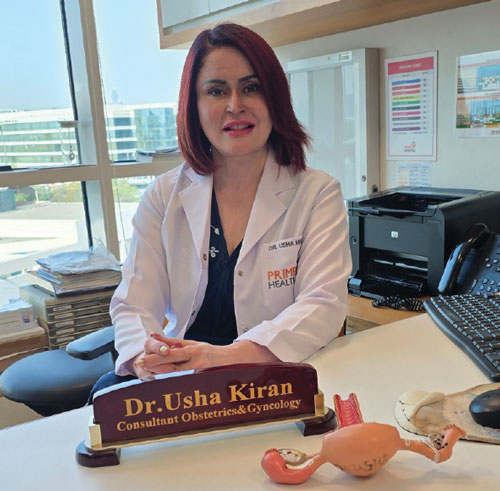 When 39-year-old Reema* walked into Dr. Usha Kiran’s consultation room at Prime Hospital, Dubai, she was exhausted physically and emotionally.
When 39-year-old Reema* walked into Dr. Usha Kiran’s consultation room at Prime Hospital, Dubai, she was exhausted physically and emotionally.
- How Laparoscopic Microwave Ablation is changing the way fibroids are being treated.
“For months, she’d been battling heavy, painful periods and a constant pressure in her lower abdomen,” recalls Dr. Usha Kiran, a UK-certified consultant in gynecology and an expert in minimally invasive surgery. “Her fibroids were affecting her work, her sleep, and even simple things like going for a walk.” But Reema was clear about one thing: she didn’t want a hysterectomy (removal of uterus) or myomectomy (removal of fibroids).
“She told me: ‘Doctor, I’m not ready to give up my uterus or have a cut on the uterus to remove fibroids. Isn’t there a way to treat this without removing it?’ That’s when I discussed the option of laparoscopic microwave ablation with her,” Dr. Usha Kiran recounted.
A game-changer
Laparoscopic Microwave Ablation (MWA) is one of the most advanced treatments for uterine fibroids, a common condition that affects up to 70 percent of women by the age of 50. Fibroids are most often diagnosed in women in their 30s and early 50s, but they can develop earlier.
“Fibroids are non-cancerous tumors that grow in or around the uterus,” explains Dr. Usha. “They can cause heavy bleeding, pelvic pain, frequent urination, or even fertility issues. Not all women with fibroids experience symptoms; many cases are asymptomatic and discovered incidentally.”
Traditionally, treating fibroids meant surgery (open or laparoscopic), either by removing just the fibroids (myomectomy) or, in many cases, removing the uterus completely. Another non-surgical treatment was uterine artery embolization, but its downside is that it compromises the blood supply to the uterus, which is not desirable for young women who want to preserve fertility.
MWA, however, offers a uterus-conserving alternative without scarring the uterus (as in myomectomy) or compromising its blood supply (as in uterine artery embolization).
 Dr. Usha Kiran
Dr. Usha Kiran
UK-certified consultant in gynecology and
an expert in minimally invasive surgery
“In microwave ablation, we insert a small probe into the fibroid using laparoscopic, keyhole surgery,” says Dr. Usha Kiran. “In simple terms, the probe emits controlled microwave energy, which heats up and destroys the fibroid tissue from the inside. There’s no cutting of the fibroid, no large sutures on the uterus, reducing the risk of future uterine rupture, and very minimal bleeding.”
According to Dr. Usha, the benefits of MWA are game-changing, especially for women who want to avoid major surgery or preserve their fertility. “Because the procedure is so precise, there’s minimal damage to surrounding uterine tissue,” she explains. “This means there’s less scarring, and in many cases, the uterus heals almost as if nothing happened.”
The Upsides
MWA also offers:
- Minimal bleeding during the procedure
- Faster recovery — most women go home the same day or the next
- Lower risk of adhesions that can impact fertility
It takes between one to three months for the fibroids to shrink, but during this period patients typically do not experience pain — unlike in uterine artery embolization, where pain can be intense and may last for up to a year.
“For women like Reema, this can mean getting back to life faster, and with their uterus intact,” says Dr. Usha.
Offering hope for motherhood again
One of the biggest questions women ask is whether they’ll still be able to have children after MWA. “The short answer is yes, in most cases,” says Dr. Usha.
“One of the major advantages of MWA is that it preserves the uterus with minimal scarring, making it an excellent choice for women wishing to maintain fertility. The risk of uterine rupture in a future pregnancy is also significantly lower compared to traditional myomectomy. However, it’s important to have a detailed discussion with your doctor, because every case is unique.”
As with any medical procedure, MWA carries some risks. “There’s a small chance of infection, or that some fibroid tissue may need a second treatment if it’s not fully ablated,” Dr. Usha explains. “But overall, MWA is considered very safe when performed by a trained specialist.”
So, who is the ideal candidate for laparoscopic microwave ablation? According to Dr. Usha Kiran, it’s women who have symptomatic fibroids but still wish to preserve their uterus. “Many of my patients come to me because they want to avoid a hysterectomy or myomectomy,” she says. “They’re looking for a solution that treats the problem without taking away a part of their body.”
MWA is also an excellent option for women who prefer minimally invasive procedures over traditional open surgeries. “This technique involves tiny keyhole incisions, which means less pain, less bleeding, and no large scars,” Dr. Usha explains. “It’s about treating the fibroid while keeping the rest of the body as untouched as possible.”
For women who want to avoid long hospital stays or significant blood loss, MWA offers another advantage: faster recovery. “Most women are back on their feet in a day or two,” says Dr. Usha. “It’s a quicker, gentler path back to normal life.”
As for Reema, her life has changed dramatically since the procedure. “Her bleeding stopped. Her energy came back. And best of all, she still has her uterus,” says Dr. Usha with a smile. “For many women, that makes all the difference.”
When Should You See a Gynecologist?
If you have heavy periods, pelvic pain, frequent urination, or trouble conceiving, don’t ignore the symptoms. “Many women live with fibroids silently for years,” says Dr. Usha. “But the sooner you seek advice, the more options you’ll have — especially uterus-sparing treatments like MWA.”


